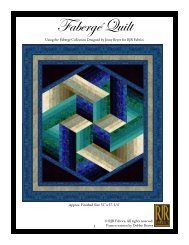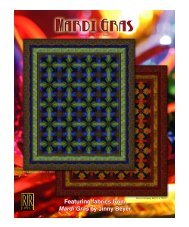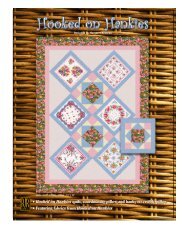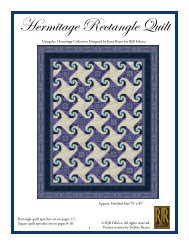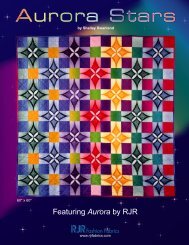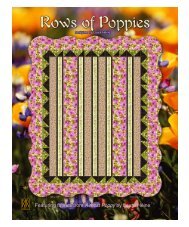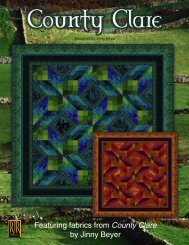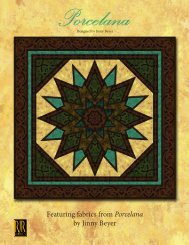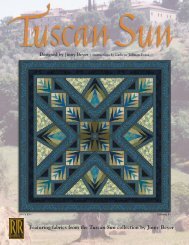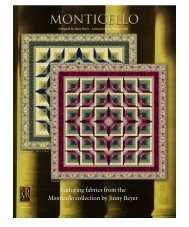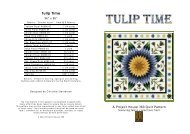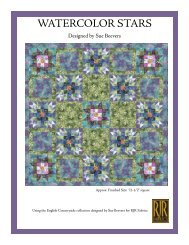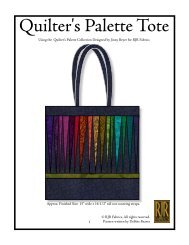You also want an ePaper? Increase the reach of your titles
YUMPU automatically turns print PDFs into web optimized ePapers that Google loves.
Designed by Jinny Beyer<br />
Winter Colorway 1<br />
Spring Colorway 2<br />
Summer Colorway 3 Autumn Colorway 4 All quilts are 73 1 /4" x 87 1 /4"
FOUR SEASONS<br />
Designed by Jinny Beyer • Instructions by Mimi Shimp<br />
Finished Quilt Size: 73 1 /4" x 87 1 /4"<br />
All seams are 1 /4". All strips are cut the width of fabric, unless instructed otherwise. Carefully trim all selvages<br />
The numbers in parentheses indicate the placement in the paper pieced tree block.<br />
Fabric Requirements for the Summer Quilt – Colorway 3<br />
Fabric # Description Fabric Swatch Style # Cutting Directions Yardage<br />
Cut 10 strips 1 1 /4" x width of fabric. Cross-cut into<br />
20 strips 1 1 /4" x 9 3 /4" and 20 strips 1 1 /4" x 10 1 /2".<br />
Cut 12 strips 3" x width of fabric. From these fabrics<br />
cross-cut into 40 rectangles 3" x 9 1 /4" (10) and 20<br />
squares 3" x 3". Cut each square in half diagonally (2).<br />
1 Tree block 6060-02 Cut 10 strips 2 1 /2" x width of fabric. Cross-cut 40 3 yds<br />
background rectangles 2 1 /2" x 3 1 /2" (4) and 40 rectangles 2 1 /2" x 6".<br />
Cut 8 strips 2 3 /4" x width of fabric (6). Cross-cut into<br />
40 rectangles 2 3 /4" x 7 1 /2" (8).<br />
2 Tree block 6059-03 Cut 4 strips 11 /4" x width of fabric. Cross-cut into<br />
40 strips 1 1 /4" x 4 1 /2" (1).<br />
3 Tree block 6059-31 Cut 5 strips 21 /2" x width of fabric. Cross-cut into<br />
40 strips 2 1 /2" x 5" (3).<br />
4 Tree block 6057-03 Cut 8 strips 31 /4" x width of fabric. Cross-cut into<br />
40 strips 3 1 /4" x 7 1 /4" (5).<br />
5 Tree block 6060-03 Cut 8 strips 23 /4" x width of fabric. Cross-cut into<br />
40 strips 2 3 /4" x 8" (7).<br />
1/4 yd<br />
3/8 yd<br />
3/4 yd<br />
3/4 yd<br />
6 Tree block 6061-03<br />
Cut 8 strips 2" x width of fabric. Cross-cut into<br />
40 strips 2" x 8" (9).<br />
1/2 yd<br />
Tree block<br />
Cut 1 strip 2" x width of fabric. Cross-cut into<br />
7 and middle 6058-03 20 squares 2" x 2". Cut 8 strips 3" x width of fabric 1 1 /2 yds<br />
border<br />
for middle border.<br />
Cut 3 strips 8 1 /2" x width of fabric. Cross-cut into<br />
12 squares 8 1 /2" x 8 1 /2". Cut 2 strips 12 1 /2" x width<br />
Alternate of fabric. Cross-cut into 4 squares 12 1 /2" x 12 1 /2",<br />
8 blocks and 6056-03 then cut each square twice diagonally for side 1 7 /8 yds<br />
triangles<br />
triangles. Cut 1 strip 8" x width of fabric.<br />
Cross-cut into 2 squares 8" x 8", then cut each<br />
square in half diagonally for corner triangles.<br />
9 Border Stripe 6055-03 Border Stripe. See Cutting Border Print directions. 8 yds<br />
10<br />
11<br />
Dark green<br />
leaves<br />
Blue and<br />
gold floral<br />
6058-03 Binding – Cut 8 strips 2 1/2" x width of fabric. 3/4 yd<br />
6056-03 Suggested Backing Fabric 5 1 /2 yds
Make sure to read the entire pattern before beginning. Refer to the quilt pictures for fabric placement. For cutting<br />
directions refer to Fabric Requirements for the Summer Quilt-Colorway 3.<br />
Fabric Requirements for the Winter (CW 1), Spring (CW 2), and Autumn (CW 4) Quilt<br />
Fabric # Description<br />
Colorway 1- Winter Colorway 2-Spring Colorway 4-Autumn<br />
Fabric Swatch Style # Fabric Swatch Style # Fabric Swatch Style #<br />
Yardage<br />
1 Middle border 6060-02 6060-02 6059-21 1 3 /4 yd<br />
2<br />
Tree block<br />
background<br />
6060-01 6060-02 6059-21 3 yds<br />
3<br />
Alternate blocks<br />
and triangles<br />
6056-02 6056-01 6057-04 1 3 /4 yds<br />
4 Tree block 6059-2 6058-01 6058-4 1/8 yd<br />
5 Tree block 6056-03 6061-02 6061-04 1/2 yd<br />
6 Tree block 6060-2 6058-02 6059-04 3/4 yd<br />
7 Tree block 6060-21 6057-1 6060-04 3/4 yd<br />
8 Tree block 6057-02 6059-01 6059-41 3/8 yd<br />
9 Tree block 6059-21 6059-03 6059-03 1/4 yd<br />
10 Binding 6060-01 6058-02 6059-04 3/4 yd<br />
Border Stripe (outer<br />
11 border and inner 6055-01 6055-02 6055-04 8 yds<br />
border)<br />
12<br />
Suggested<br />
Backing<br />
6056-01 6056-02 6056-04 5 1 /2 yds
Cutting<br />
1. Cut all pieces as indicated in the cutting chart. The<br />
pieces for the trees are cut larger than the area they will<br />
cover. Stack the cut pieces in order from #1-#10, as<br />
needed for piecing.<br />
2. Copy the tree block at 200% and make 20 copies of the<br />
left side and 20 copies of the right side. (Note: In order<br />
to print out an accurate template, use a larger paper size<br />
than 8 1 /2" x 11 ".) The unfinished block size is 10 1 /2" which<br />
includes the dotted line outside the solid edge of the<br />
block. Make sure the block measures 10 1 /2" before<br />
removing paper.<br />
General Information for Foundation Piecing<br />
1. Sew by machine only. Hand piecing is not recommended<br />
on paper.<br />
2. Use a slightly smaller stitch than usual.<br />
3. Do not backstitch. Take 2-4 stitches beyond the<br />
intersecting lines to secure.<br />
4. When the block is completed, trim with rotary tools on the<br />
1/4" seam allowance indicated by the dashed line around<br />
the outside edge. Carefully remove paper by tearing<br />
against the stitching lines. It is not necessary to remove<br />
every small bit of paper left over after removing the larger<br />
pieces of paper.<br />
Constructing the Tree Block<br />
1. <strong>Fabrics</strong> have been cut large enough for the numbered<br />
areas that will be covered, plus a generous seam allow<br />
ance. (This step has been covered in Cutting #1.)<br />
2. Place the fabric for area #1 on the unprinted side of the<br />
paper, right side up. Hold it up to the light and look<br />
through the printed side of the paper foundation to check<br />
the placement of the fabric. There should be a generous<br />
seam allowance extending beyond all edges of the area<br />
#1. Place the fabric for area #2 on the unprinted side<br />
where it is going to be after the seam is sewn. Then flip it<br />
down, right sides together with the fabric from area #1.<br />
There should be a generous 1 /4" seam allowance<br />
extending into area #2. Pin first and then check again<br />
for placement. Stitch on the line between areas #1 and<br />
#2 on the printed side of the foundation. Stitch directly on<br />
the line for accurate results.<br />
3. Trim excess fabric along the stitching line between #1<br />
and # 2 to about 1 /4" of seam allowance. This can be<br />
done with scissors or rotary tools. Flip fabric to cover<br />
area # 2.<br />
4. Press each seam with a warm dry iron after it is sewn and<br />
flipped. Steam can cause paper to become wet. Make<br />
sure all the fabric is pressed completely to the side to<br />
avoid tucks when adding the rest of the pieces. Continue<br />
to add fabric pieces in numeric order by repeating above<br />
steps. Complete 20 left sides and 20 right sides of the<br />
tree block.<br />
Placing fabrics #1 and #2.<br />
Stitching line.<br />
Stitching fabrics #1 and #2.<br />
View after stitching.<br />
Placing fabric #3.<br />
Stitching line.<br />
Stitching fabric #3.<br />
View after stitching.
5. Once all fabrics are stitched to the paper block, piece the<br />
left sides and right sides of the trees together.<br />
7. Stitch the 1 1 /4" x 9 3 /4" strips of Fabric 1 to the left side<br />
of the tree block. Then stitch the 1 1 /4" x 10 1 /2" strips to<br />
top of the block. Square the block to 10 1 /2" before<br />
removing the paper.<br />
6. Stitch the 2" squares of Fabric 7 to the tops of the trees<br />
as shown.<br />
Press triangle and square<br />
Stitching line. corner, if necessary.<br />
8. Complete 20 tree blocks.<br />
Cutting the Border Stripe<br />
All strips are cut lengthwise from the fabric.<br />
1. Cut the wide border stripe<br />
4 7 /8" wide x the length of the<br />
fabric. The 1 /4" seam allowance<br />
beyond the outside of the<br />
stripe is included in the 4 7 /8"<br />
measurement. Cut 4 strips<br />
lengthwise.<br />
3. Cut the narrow strips on the outside<br />
edge of the gold stripe to use around the<br />
alternate squares, sides and the border<br />
triangles. Cut 2 strips 1 1 /2" x the length<br />
of the fabric, then cross-cut into 70<br />
segments consisting of 5 scrolls each,<br />
with a mirror imaged motif in the center.<br />
The length of the strip of 5 scrolls is<br />
approximately 15 1 /2" long.<br />
2. The narrow border stripe is<br />
used in two areas of the quilt<br />
and is cut differently for each.<br />
For the inner border, cut the<br />
narrow stripe 1 /4" from each<br />
edge of the gold stripe. Cut the<br />
strips 2" wide x the length of<br />
fabric. Cut 4 strips lengthwise.<br />
for alternate<br />
squares, sides<br />
and the border<br />
triangles<br />
Cross-cut into 5-motif sections.<br />
Cut<br />
Cut<br />
Cut<br />
2”<br />
for inner<br />
border
Constructing the Alternate Block<br />
1. Fold the 8 1 /2" squares cut from Fabric 8, in half twice to<br />
get the centers of each side. Mark the center of the scroll<br />
strips and measure 4 1 /4" out from each side of center.<br />
Miter corners using a 45° right angle triangle.<br />
Cut 45° angle.<br />
Center of strip.<br />
4 1/4” on each side of center.<br />
2. Sew strips to each side of the 8 1 /2"<br />
squares, starting and stopping the<br />
stitches 1 /4" from each edge. Sew<br />
mitered corners. Make 12 blocks.<br />
Cut 45° angle.<br />
Constructing the Side and Corner Triangles<br />
1. Fold the short sides of the triangles<br />
cut from the 12 1 /2" squares of<br />
Fabric 8 in half to find the center of<br />
each side. Following step 3 for<br />
alternate block, miter the strips and<br />
sew to each straight side of the<br />
triangle. Make 14 triangles.<br />
2. For the corner triangles, fold the<br />
triangles cut from the 8" x 8"<br />
squares of Fabric 8, in half to find<br />
the center. Stitch one mitered scroll<br />
strip to the long side of the triangle.<br />
Make 4 triangles.<br />
Assembling the Quilt Top<br />
1. The tree blocks and alternate blocks<br />
are turned on point and stitched<br />
together in a diagonal set. The side<br />
triangles are treated as blocks for<br />
piecing this quilt.<br />
2. Stitch blocks together into diagonal<br />
rows, then stitch the rows together.<br />
3. Stitch the corner triangles on after all<br />
the rows have been stitched<br />
together.<br />
4. For the inner border cut the four 2"<br />
wide narrow stripe from Fabric 9,<br />
into two 62" long strips and two 78"<br />
long strips.
Jinny’s Method for Framing a Rectangular Quilt with a Border Print<br />
Because <strong>Four</strong> <strong>Seasons</strong> is rectangular, the side border print<br />
strips must be pieced to ensure perfectly matching motifs in<br />
the border corners, as on the featured quilt. Here are Jinny’s<br />
step-by-step instructions for cutting and piecing the strips.<br />
1. Place the 2" x 62" inner border strip across the middle of<br />
the quilt, centering a mirror imaged motif from the border<br />
print at the exact center of the quilt (Figure 1). Use a<br />
right-angle, 45° triangle to mark miter along one end of<br />
the strip, positioning triangle at edge of quilt as indicated<br />
(see arrow in diagram) to ensure that the seam allowance<br />
is included. Mark, then cut the miter.<br />
2. Carefully pick up the mitered edge of the border strip and<br />
fold it at the center, on a mirror imaged motif, to the<br />
opposite side of the quilt. Position it at the precise point<br />
where the miter will be, making sure the fabric design<br />
matches. Cut the second miter.<br />
3. Using this first mitered strip as a pattern, place it on the<br />
remaining 62" inner border strip, matching the design<br />
exactly, and cut an identical strip. Reserve these two<br />
strips for the top and bottom inner border.<br />
Figure 1 – Cut Top & Bottom Inner Border Strips
4. Place one of the cut top/bottom inner border strips on one<br />
of the 2" x 78" border print strips, matching the fabric<br />
design. Cut one miter to match the miter on the cut strip.<br />
Place the newly cut strip along the length of the quilt<br />
through the center, with the miter at the edge of the quilt<br />
(Figure 2). Bring the strip to the exact center of the quilt and<br />
cut it off 1 /4" beyond the center.<br />
Cutting line<br />
Sewing line<br />
Figure 2 – Cut Mirror-Image Half Strips for Inner Border Sides
5. Using this cut strip as a guide, cut one more piece<br />
identical to it and two strips that are mirror images of the<br />
first piece. Sew two mirror-imaged strips together to form<br />
the longer side borders.<br />
6. To prepare to sew the inner border strips to the quilt,<br />
begin by pinning the midpoint of one of the strips to the<br />
middle of one of the edges of the quilt. Pin the corners<br />
next. Then find the midpoint of each half and pin.<br />
Continue finding midpoints and pinning. Finally, ease in<br />
any fullness, pinning carefully all along the edge. Sew all<br />
four border strips to the quilt. Sew the miters last.<br />
7. For the middle border, piece the 3" wide strips of Fabric 7<br />
together to make 2 strips 65" long and 2 strips 79" long.<br />
Follow the procedure for cutting and attaching mitered<br />
borders.<br />
8. Repeat steps 1-6 for outer border.<br />
9. Layer the backing, batting, and quilt top; baste. Quilt,<br />
bind and finish as desired.<br />
Figure 3 – Piece Side Strips
Templates<br />
(Shown at 50%, enlarge to 200% when printing)<br />
0 1" 2" 3"<br />
Use this 3" scale to insure the accuracy of your printout.



